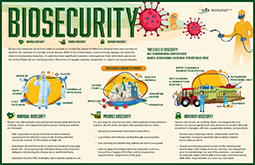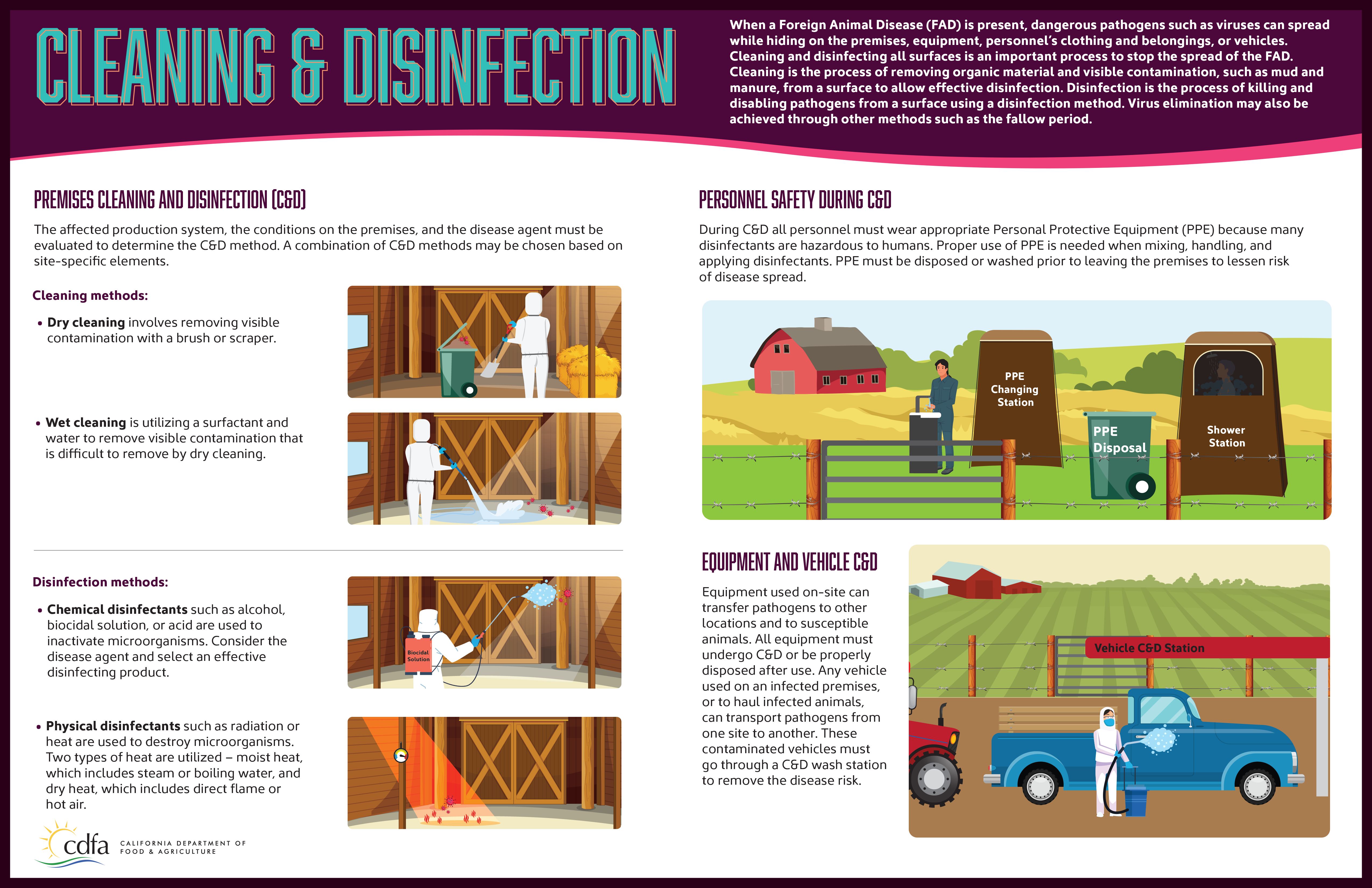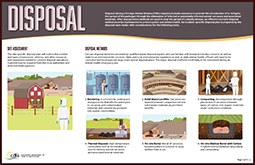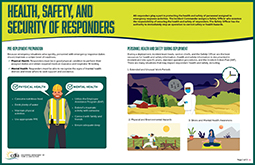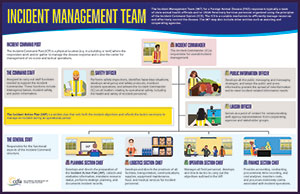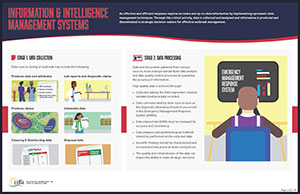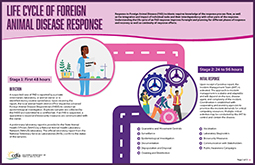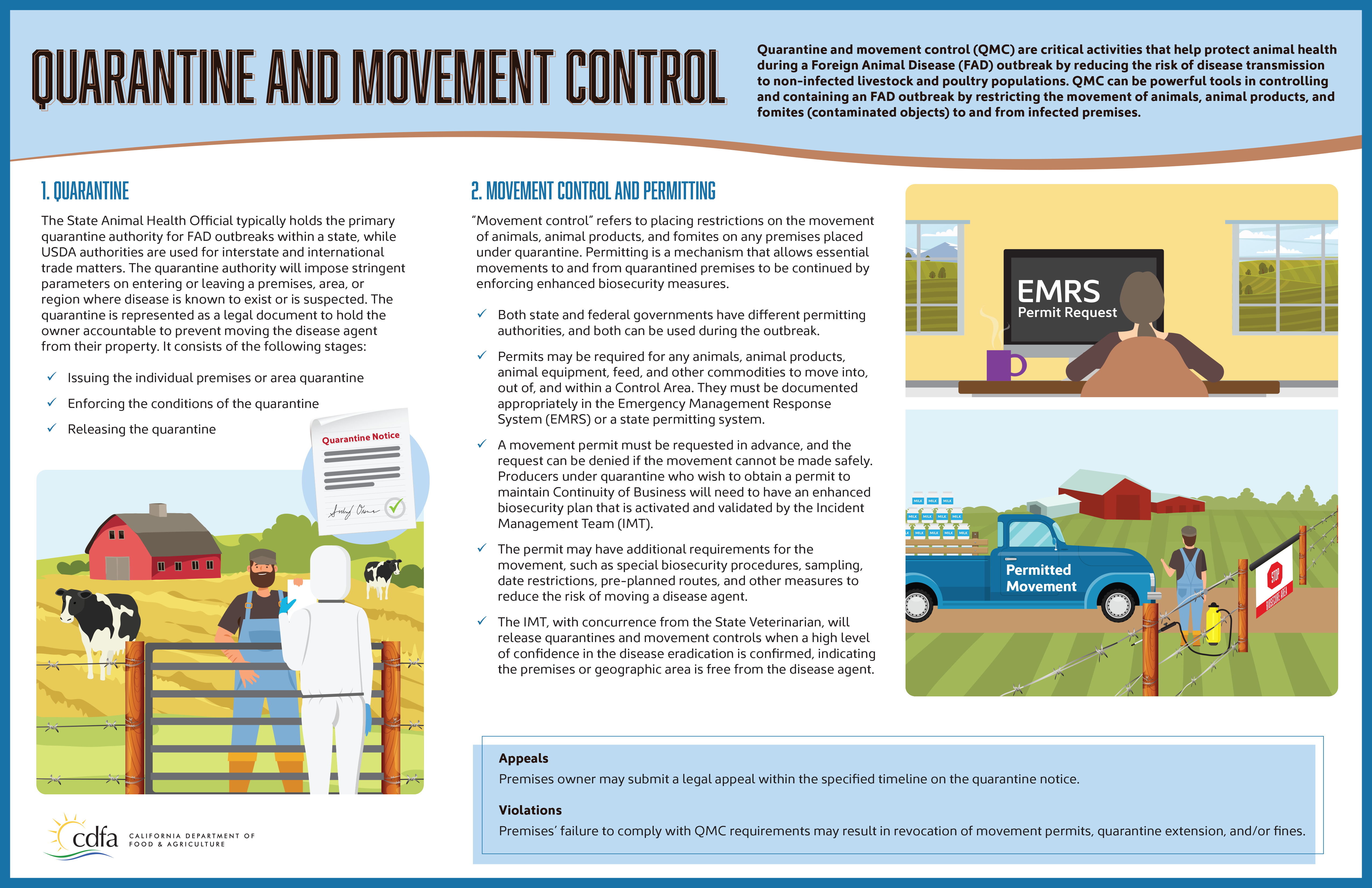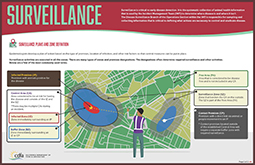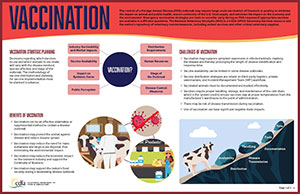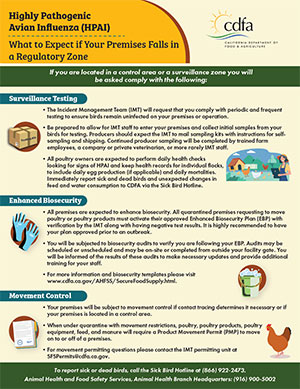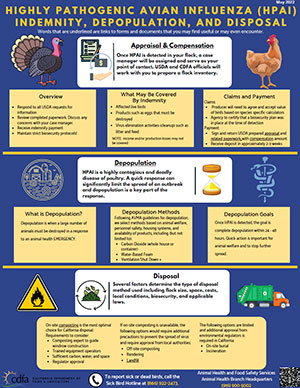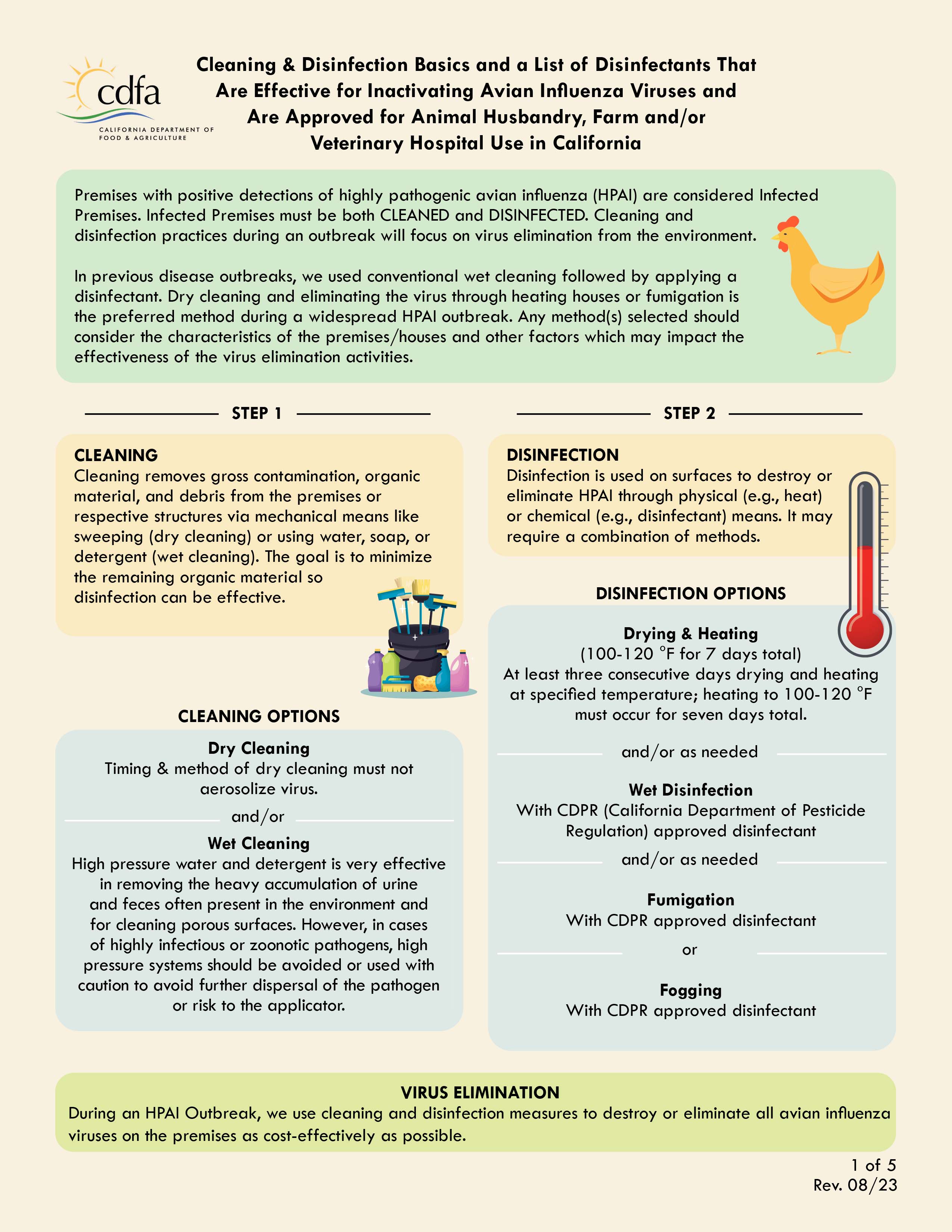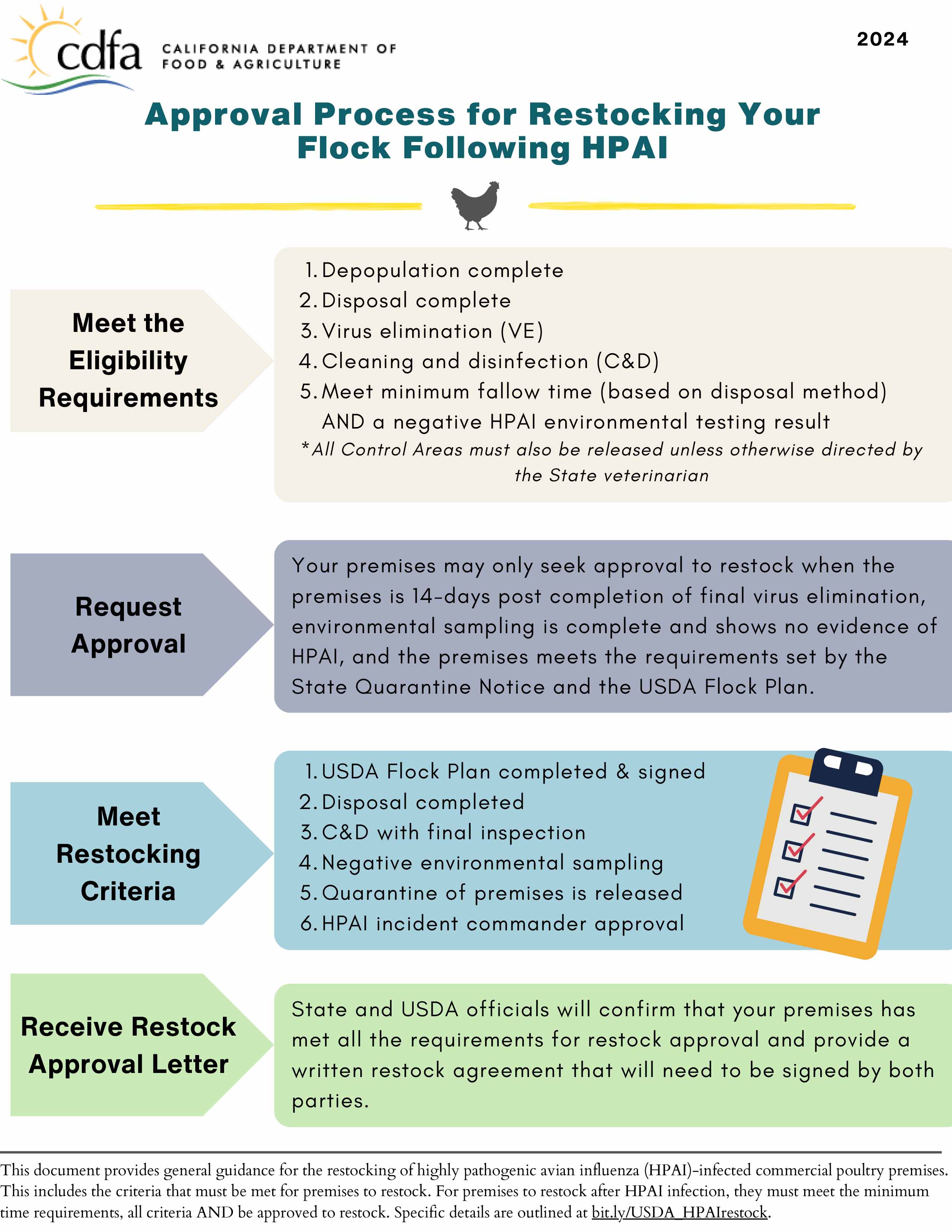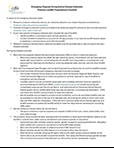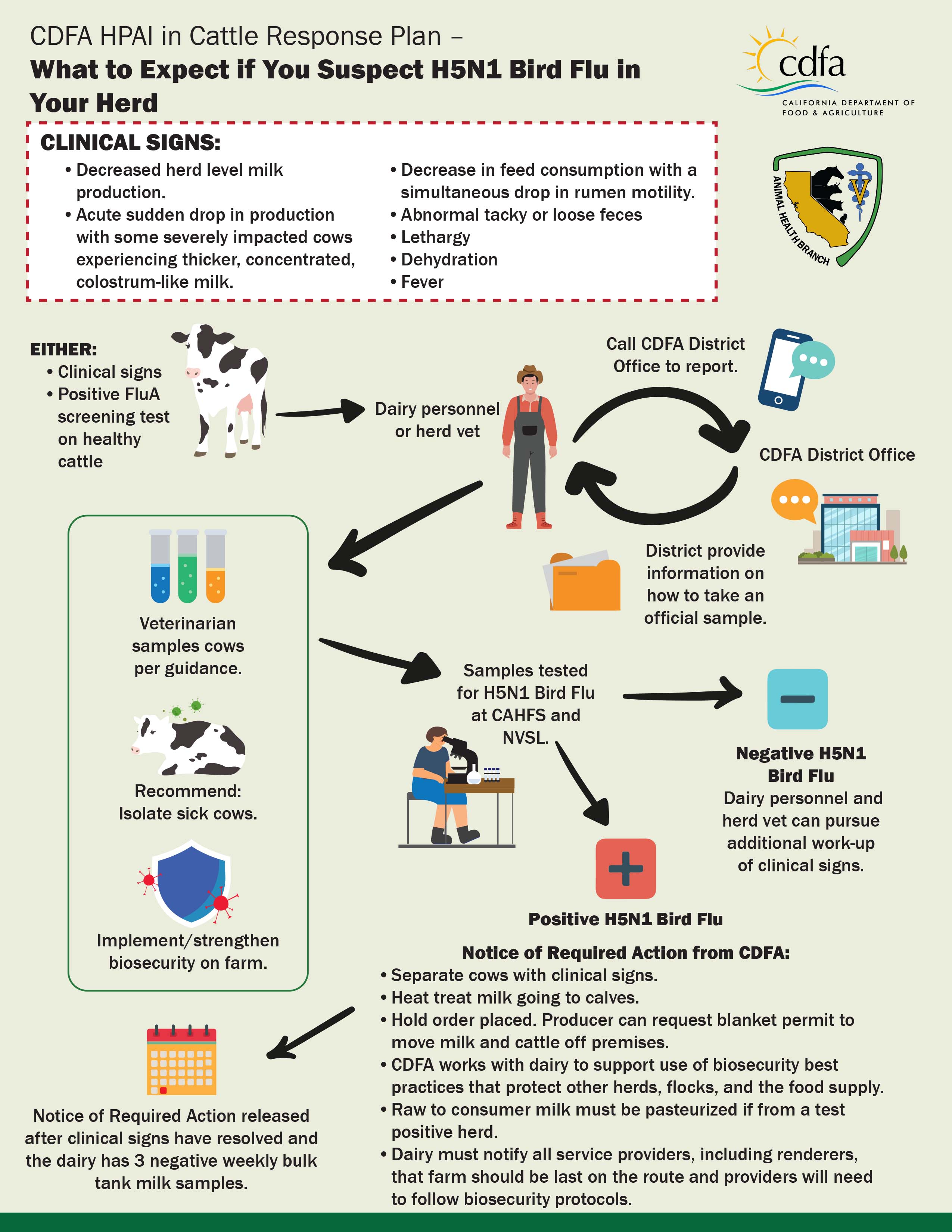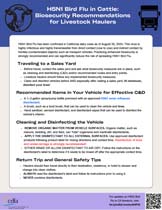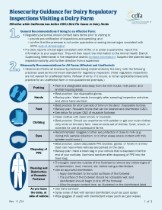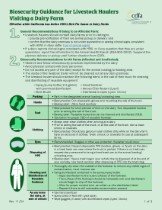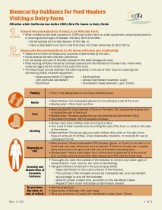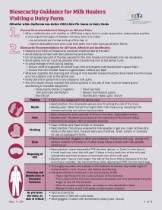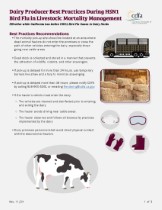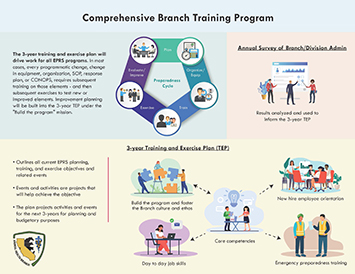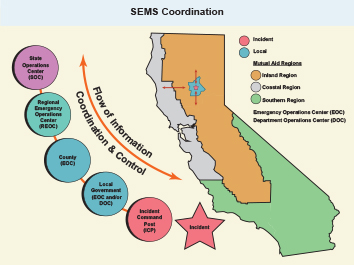Preparedness and Response
The Animal Health Branch Emergency Preparedness and Response Section (EPRS) supports two (2) primary mission areas: foreign animal disease (FAD) outbreaks and the California Animal Response Emergency System (CARES) and supports a number of other emergencies impacting the Animal Health and Food Safety Services Division, including food safety, food supply disruptions, and extreme weather events.
Trainings
Infographics
Animal Health Emergency Preparedness and Response Critical Activities
Videos

Introduction to the Threats of Foreign Animal Diseases
|
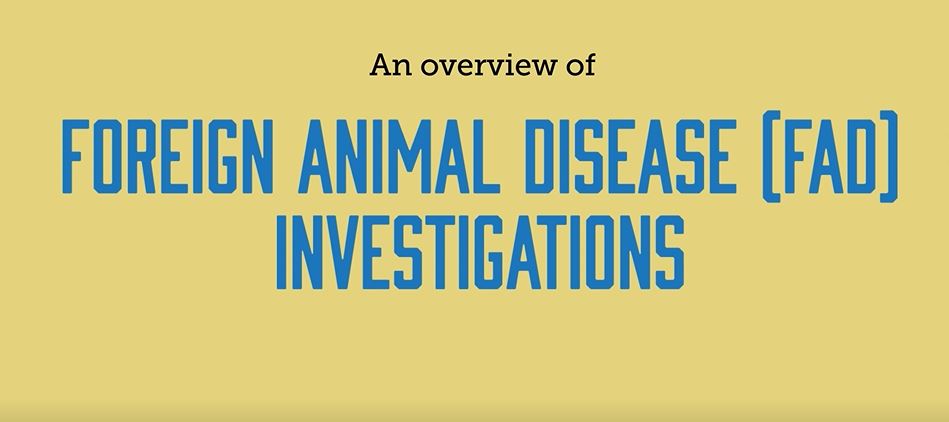
An Overview of Foreign Animal Disease Investigations
|

Lifecycle of a Foreign Animal Disease Response
|
Highly Pathogenic Avian Influenza (HPAI) in Poultry
- Birds (And Their Products) From HPAI Control Areas Require Permits to Enter California | (Printer Friendly)
H5N1 in Livestock
California manages FAD outbreaks in Unified Command with United States Department of Food and Agriculture (USDA) Veterinary Services. EPRS oversees the development of a Blended Incident Management Team, with leadership representation in Command and General Staff from both CDFA and USDA personnel. CDFA has deployed the California Blended Incident Management Team for several FAD outbreaks, including the 2015 Highly Pathogenic Avian Influenza (HPAI) outbreak and the 2018-2020 virulent Newcastle disease (vND) outbreak. CDFA members of the California team blended with the National Incident Management Team to continue Unified Command representation throughout the 2018–2020 vND outbreak response.
During an Emergency, EPRS provide staffing and/or assistance to the following:
- State Operations Center (SOC): The California Governor’s Office of Emergency Services (Cal OES) operates the SOC at the State level in SEMS. It is responsible for centralized coordination of state resources in support of the three Regional Emergency Operations Centers (REOC). It is also responsible for providing updated situation reports to the Governor and Legislature.
- Regional Emergency Operations Centers (REOC): In SEMS, the REOC manages and coordinates information and resources among Operational Areas within the mutual aid region and between the Operational Areas and the SOC at the State Level. The REOC also coordinates overall State agency support for emergency response activities with the Region.
- Department Operations Center (DOC): Each State agency may activate a department operations center to manage information and resources assigned to the incident. If a DOC is activated, an agency representative or liaison may be deployed to facilitate information flow between the two facilities. A DOC may be used by a Department (such as fire, law, health, animal care services, public works) at any level above the field level as a coordination point for agency resources and facilities during major incidents and planned events.
- Incident Command Post (ICP): The ICP is the location where the incident commander operates during response operations and oversees all incident operations. Establishing a single Incident Command Post is essential to an effective Unified Command. The ICP is positioned outside of the hazard zone, but close enough to maintain command and situational awareness. The ICP is the location where essential functions are collocated such as the responsible officials; command (Commander, Public Information Officer, Safety Officer, and Liaison Officer) and general staff (Operations, Planning/Intelligence, Logistics and Finance/Administration); and planning elements.
- Unified Command (UC): A unified command involves two or more individuals sharing the authority normally held by a single incident commander. Unified Command is a team effort process, allowing all agencies with geographical or functional responsibility for an incident, to assign an Incident Commander to a Unified Command organization. The Unified Command then establishes a common set of incident objectives and strategies that all can subscribe to. This is accomplished without losing or giving up agency authority, responsibility, or accountability. Unified Command represents an important element in increasing the effectiveness of multi-jurisdictional or multi-agency incidents. As incidents become more complex and involve more agencies, the need for Unified Command is increased.
- Multiagency Coordination System (MACS): MACS is a component of the California Standardized Emergency Management System (SEMS) and National Incident Management System (NIMS). It is essential to integrating and coordinating multi-agency emergency response and management. Responding agencies will coordinate and support emergency management and incident response objectives through the development and use of integrated MACS and MAC Groups. This includes developing and maintaining connectivity capability between ICP, local 9-1-1 Centers, local Emergency Operations Centers (EOC), REOC, the SOC, and federal EOC (the Regional Response Coordination Center (RRCC)) and National Response Framework (NRF) organizational elements.
- Joint Information Center (JIC): This is a location where multiple agencies are providing public information, the lead agencies will work together to analyze the information available and provide a consistent message to the public and the media. Where practical, the agencies will activate a Joint Information Center to facilitate the dissemination of consistent information
In an emergency response, EPRS is required to use ICS, SEMS, and NIMS:
- The Incident Command System (ICS) is a standardized, on-scene, all-risk incident management concept and refers to the combination of facilities, equipment, personnel, procedures, and communications operating within a common organizational structure to match the complexities and demands of single or multiple incidents without being hindered by jurisdictional boundaries. It is designed to aid in the management of resources during incident response. ICS is incorporated into SEMS and NIMS.
- The Standardized Emergency Management System (SEMS) is the cornerstone of California's emergency response system and the fundamental structure for the response phase of emergency management. SEMS is required by the California Emergency Services Act (ESA) for managing multiagency and multijurisdictional responses to emergencies in California. The system unifies all elements of California's emergency management community into a single integrated system and standardizes key elements. SEMS incorporates the use of the Incident Command System (ICS), California Disaster and Civil Defense Master Mutual Aid Agreement (MMAA), the Operational Area (OA) concept, and Multi-Agency Coordination (MAC) process. State agencies are required to use SEMS, and local government entities must use SEMS in order to be eligible for any reimbursement of response-related costs under the State's disaster assistance programs.
- In addition to the Standardized Emergency Management System (SEMS), the State and its political subdivisions are responsible for compliance with the requirements of the National Incident Management System (NIMS) as defined in the Homeland Security Presidential Directives. The State promotes and encourages NIMS adoption by associations, utilities, non-governmental organizations (NGO), private sector emergency management, and incident response organizations to enhance emergency management effectiveness. SEMS and NIMS are designed to be compatible and are based on similar organizational principles.
EPRS administers the CARES Unit. CARES is a statewide emergency management operational guidance supporting state and local government for animals in disasters. CARES is supported by a partnership of public and private organizations that commit resources and expertise to prepare for and respond to animals in disasters. When the local government emergency management reasonably exhaust their resources or are fully committed, CDFA works closely with the State Operations Center (SOC) to mission coordinate resource requests that reach the state level, SOC.
EPRS primary focus areas:
- Animal Disease Outbreaks: California manages foreign and domestic animal disease outbreaks in Unified Command with the United States Department of Agriculture (USDA) Veterinary Services. EPRS oversees the development of a Blended Incident Management Team, with leadership representation in command and general staff from both CDFA and USDA personnel.
- Disaster Response: EPRS is responsible for the California Animal Response Emergency System (CARES), a statewide emergency management operational system supporting animals in disasters.
EPRS is comprised of five (5) functional programs that support the mission areas: Planning, Training, Exercise, Outreach, and Epi/Analysis. Some of EPRS's current projects are:
- National Animal Disease Preparedness and Response Program Training and Exercise Project (NADPRP);
- Animal Carcass Composting School; and
- Low Pathogenicity Avian Influenza (LPAI) Project.
During a FAD response, CDFA has the following responsibilities:
- Assign the incident management positions to the incident.
- In coordination with USDA, form Unified Command and direct the overall animal health response activities.
- Develop statewide strategy and policy specific to disease eradication.
- Issue animal and animal product quarantines, including isolation, destruction orders, and decontamination orders.
- Arrange for individual indemnification in cooperation with USDA.
- Activate the DOC and coordinate CDFA resource requests and deployment to the incident.
- Establish ICPs and Area Command and provide incident management teams in cooperation with USDA and other local, State, and Federal agencies.
- Provide public information and participate in the Joint Information Center.
Response Resources
Resources
Follow Us
Contact Us
CDFA Animal Health and Food Safety Services,
Animal Health Branch
Sacramento, California 95814
Phone: 916-900-5002
Fax: 916-900-5333
Email: CDFA.AHB_EPRS@cdfa.ca.gov


